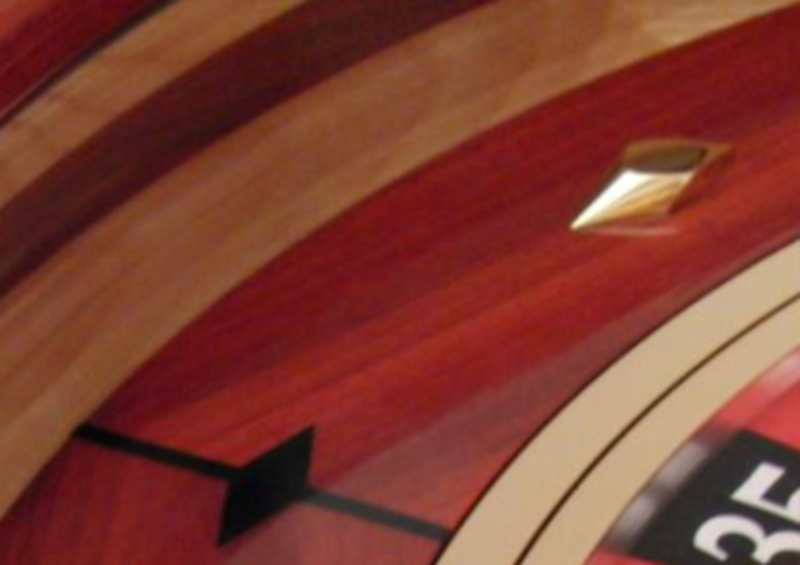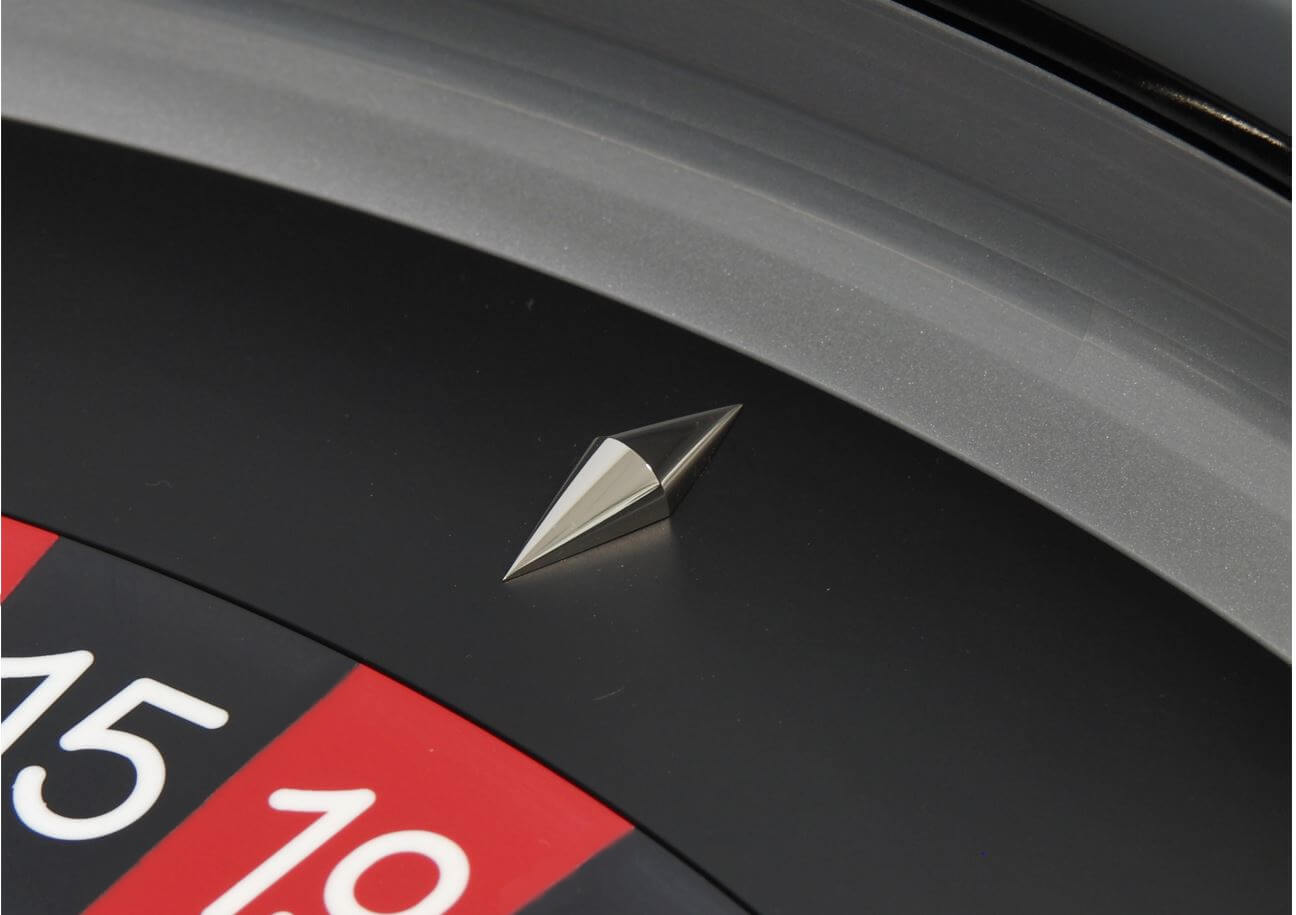The parts of a roulette wheel the visible surfaces of which are usually made of wood are the cone* and the bowl**. Besides wood, these surfaces are sometimes made in combination with or entirely of other materials that will also be mentioned later. In any case, the choice of these materials is a very important issue that reflects not only on the design and cost but also on the functional and aesthetic durability of the device, and the prevention of loss in its use. For that reason, it is important that the customer’s choice of product and its features, which is ultimately decisive for the choice of the materials, is based on a sufficient understanding of this specific matter.
Wood
The use of wood has its roots in traditional, hand-operated roulettes, and wood as such is an indispensable part of the image we think of when talking about the roulette wheel. With the advent of automated roulettes, the use of this material has however become more complicated.
Wood as such is a natural material of irregular structure that does not tolerate drying and, on the other hand, a multitude of heat sources such as various engines and electronic components located in the enclosed space below and around the automated roulette wheel do just that. In such conditions, wood has a natural tendency to deform and crack and the stability of dimensional, mechanical and aesthetic properties of visible surfaces, especially those over which the ball passes, is one of the key quality factors of any roulette wheel.
From a strictly technical point of view, the easiest way to meet this challenge is to use alternative industrial materials with a homogeneous structure, with or without a combination of veneers. By using such materials, the required technical properties can be achieved in a more cost-efficient way. Therefore, in situations of a modern roulette wheel environment, this is also a logical choice. However, besides the tradition of making roulette wheels, natural wood, just like gold, has an irresistible appeal and therefore, despite the availability of many alternatives, it is still the most sought after material.
From a strictly technical point of view, the easiest way to meet this challenge is to use alternative industrial materials with a homogeneous structure, with or without a combination of veneers. By using such materials, the required technical properties can be achieved in a more cost-efficient way. Therefore, in situations of a modern roulette wheel environment, this is also a logical choice. However, besides the tradition of making roulette wheels, natural wood, just like gold, has an irresistible appeal and therefore, despite the availability of many alternatives, it is still the most sought after material.
Veneer
Veneer is the closest alternative to solid wood, being in fact a thin sheet of wood attached to the base by gluing. Although its surface is identical to solid wood, what reveals that a product is not of solid wood are the curved surfaces which the veneer cannot be glued to.
An example of a wooden bowl of a roulette wheel made using a combination of industrial materials and veneer
As in the case of solid wood, regardless of aesthetic, due to the impossibility of ensuring the required flatness of the surface, veneer is not a recommended material for cones. In other aspects, roulette wheels made of veneer can be of the same quality, and in terms of production costs a more cost-efficient alternative to quality roulette wheels made of precious wood.
MDF
Medium Density Fiberboard (MDF) is an industrial material with a good cost-performance ratio. The material absorbs moisture but due to its homogeneous structure, changes in humidity will not necessarily cause uneven deformations. When used for the surface layer of the visible parts of the roulette wheel, it is varnished in a color of choice which makes it flexible in terms of design and particularly suitable for modern environments. Also, due to the necessity of varnishing and the impossibility of ensuring the required dimensional uniformity, the material is not recommended for cones.
Mineral-acrylic composites
These materials are known under various brands, and are often used in the manufacture of kitchen and bathroom furniture. The technical properties of these materials are generally excellent, they are easy to process, do not absorb moisture, have very good resistance to wear and temperature fluctuations. Also, the materials are available in various designs ranging from solid colors, colors with effect, to imitations of natural stone. However, the range of available designs does not cover wood, the traditional material for roulettes, and the price of the material is quite high. For this reason, this material is most often used in a part of the wooden bowl called balltrack and less often for making cones and separator rings. Compared to other variants, a balltrack made of Corian generally has a higher resistance to wear due to the ball rotation, and for this reason we recommend it for this purpose.
Foils, “carbon fibers”
Subject to a good choice of foil, professional installation, and dimensionally stable base of adequate hardness, the foil can be a satisfactory alternative to wood. Nowadays, some foils are so sophisticated that they are applied to vehicle body parts most exposed to external mechanical influences. Although it cannot visually replace the look of precious wood, foils are available in a wide range of designs and can fit well into a modern environment.
Carbon fiber-reinforced polymers have been increasingly used in the manufacture of various products in recent years. Sometimes their use is based on specific requirements for mechanical properties, as is the case, for example, in the production of racecar parts. However, sometimes this expensive material is used even where its specific mechanical properties are not better than some other, much cheaper materials, which is the case in the production of gaming devices. Namely, properties such as extremely low specific weight, tensile strength, corrosion resistance, electrical conductivity are not of special importance in the case of a roulette wheel and therefore from a technical point of view there is no justification for the use of this expensive material. If a woven carbon fiber pattern is an esthetic requirement, we will of course not judge it, but in that case, in our opinion, a foil with woven carbon fiber pattern is a more optimal choice. In this way, the essential mechanical properties are not impaired, and the cost is significantly lower. In any case, it is important to know that the use of carbon fibers does not improve the quality of the roulette wheel and as such does not justify its higher price.
Comparison of characteristics of wood and most common alternatives to wood in the production of automated roulette wheels
*Cone
Cone is the rotating part of a roulette wheel, of truncated cone shape, surrounded with the separator ring, and with the turret in the center.
** Wooden bowl
Static part of the roulette wheel, along which the ball travels.







